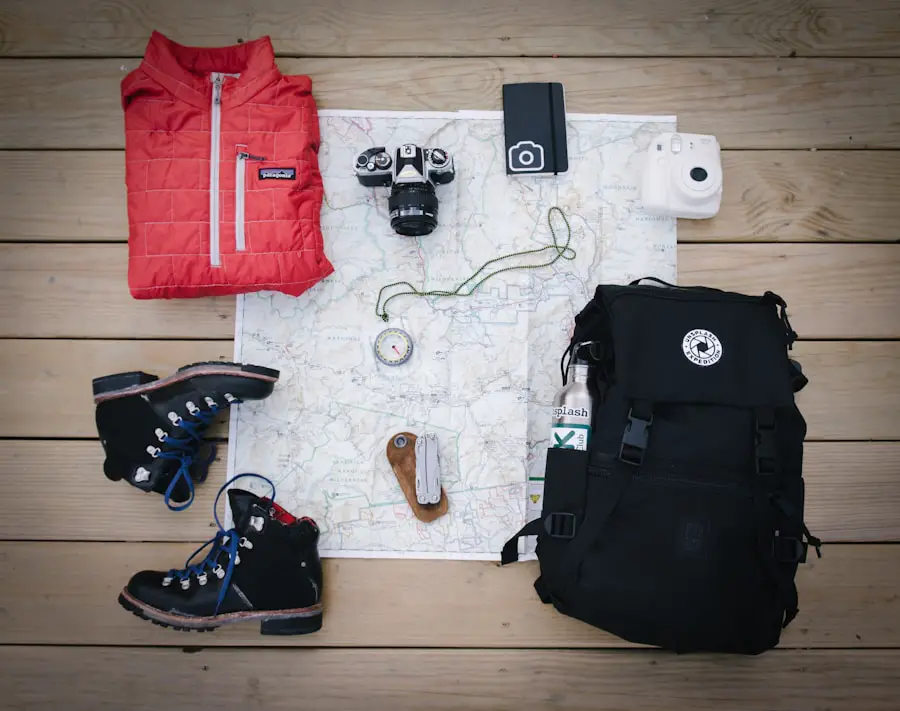When embarking on a hiking adventure, the significance of appropriate attire cannot be overstated. Proper hiking clothing serves as a protective barrier against the elements, ensuring that hikers remain comfortable and safe throughout their journey. The right attire not only enhances performance but also contributes to an enjoyable experience in the great outdoors.
Wearing suitable clothing can prevent issues such as chafing, overheating, or hypothermia, which can quickly turn a pleasant hike into a distressing ordeal. Moreover, the psychological aspect of wearing the right gear should not be overlooked. When hikers feel comfortable and well-equipped, they are more likely to enjoy their surroundings and focus on the beauty of nature rather than being distracted by discomfort.
This mental clarity can enhance the overall experience, allowing individuals to connect more deeply with their environment. Therefore, investing time and resources into selecting proper hiking attire is essential for both physical well-being and mental enjoyment.
Key Takeaways
- Proper hiking attire is important for comfort, protection, and safety on the trail.
- Choosing the right footwear is crucial for preventing blisters, providing support, and maintaining stability.
- Layering clothing for hiking allows for easy temperature regulation and protection from the elements.
- Selecting the best fabrics for hiking clothing can help with moisture-wicking, breathability, and durability.
- Essential accessories such as hats, sunglasses, and sunscreen are important for sun protection and overall comfort while hiking.
Choosing the Right Footwear for Hiking
Footwear is arguably one of the most critical components of hiking attire. The right shoes or boots can make a significant difference in a hiker’s performance and comfort level. When selecting footwear, it is essential to consider the type of terrain that will be encountered.
For instance, rugged trails with loose rocks and uneven surfaces may require sturdy hiking boots with excellent ankle support and a robust tread pattern to provide traction. Conversely, well-maintained paths may allow for lighter trail shoes that offer breathability and flexibility. Fit is another crucial factor when choosing hiking footwear.
Shoes that are too tight can lead to blisters and discomfort, while those that are too loose may cause instability and increase the risk of injury. It is advisable to try on hiking shoes with the socks intended for use during hikes, as this can affect the fit significantly. Additionally, considering the break-in period is vital; new boots should be worn on shorter walks before tackling more extended hikes to ensure they mold comfortably to the feet.
Layering for Comfort and Protection

Layering is a fundamental principle in outdoor clothing that allows hikers to adapt to changing weather conditions effectively. The layering system typically consists of three main layers: a base layer, an insulating layer, and an outer shell. The base layer is designed to wick moisture away from the skin, keeping hikers dry and comfortable.
Fabrics such as merino wool or synthetic materials are excellent choices for this layer, as they provide breathability while managing sweat. The insulating layer serves to retain body heat, which is particularly important in cooler temperatures. Fleece jackets or down vests are popular options for this layer, as they provide warmth without adding excessive bulk.
Finally, the outer shell protects against wind, rain, and snow. Waterproof and breathable materials like Gore-Tex are ideal for this layer, ensuring that hikers remain dry while allowing moisture from sweat to escape. By utilizing this layering system, hikers can easily adjust their clothing to maintain comfort throughout their journey.
Selecting the Best Fabrics for Hiking Clothing
| Fabric Type | Features | Advantages |
|---|---|---|
| Merino Wool | Natural fiber, moisture-wicking, odor-resistant | Regulates body temperature, resists odor, wicks moisture away from the skin |
| Synthetic (Polyester, Nylon) | Quick-drying, lightweight, durable | Good for high-intensity activities, dries quickly, retains shape and color |
| Spandex/Elastane | Stretchy, form-fitting | Provides flexibility and freedom of movement, retains shape |
| Polypropylene | Water-resistant, insulating | Keeps moisture away from the skin, provides warmth in cold conditions |
The choice of fabric plays a pivotal role in the performance of hiking clothing. Natural fibers like cotton may seem comfortable but are often unsuitable for hiking due to their tendency to retain moisture. When cotton gets wet, it loses its insulating properties and can lead to chilling effects in cooler weather.
Instead, synthetic fabrics such as polyester and nylon are preferred for their moisture-wicking capabilities and quick-drying properties. Merino wool has gained popularity among hikers for its unique combination of warmth, breathability, and odor resistance. Unlike traditional wool, merino wool is soft against the skin and does not cause itching.
It effectively regulates body temperature, making it suitable for both warm and cool conditions. Additionally, many outdoor brands now offer hybrid fabrics that combine the best features of different materials, providing enhanced performance tailored to specific hiking needs.
Essential Accessories for Hiking
In addition to clothing and footwear, various accessories can significantly enhance a hiker’s experience. A well-fitted backpack is essential for carrying supplies such as water, food, first aid kits, and navigation tools. When selecting a backpack, consider factors such as capacity, weight distribution, and comfort features like padded straps and hip belts.
A good backpack should allow for easy access to essentials while distributing weight evenly across the body. Other accessories include hats and gloves that provide protection from sun exposure or cold temperatures. A wide-brimmed hat can shield the face from harmful UV rays while also keeping the head cool on hot days.
Conversely, insulated gloves are crucial for maintaining dexterity and warmth in colder climates. Additionally, sunglasses with UV protection are vital for safeguarding the eyes from glare and harmful rays during long hikes in bright conditions.
Tips for Dressing for Different Weather Conditions

Hot Weather Hiking
In hot weather, lightweight and breathable fabrics are crucial to prevent overheating. Loose-fitting clothing allows air circulation while protecting against sunburn. It is also essential to wear a wide-brimmed hat and apply sunscreen liberally to exposed skin.
Cold and Wet Conditions
In cold or wet conditions, layering becomes even more critical. Start with a moisture-wicking base layer to keep sweat away from the skin, followed by an insulating layer for warmth. The outer shell should be waterproof or water-resistant to protect against rain or snow.
Be Prepared for Changing Conditions
It’s also wise to carry extra layers in case temperatures drop unexpectedly or if weather conditions change rapidly during the hike.
Considerations for Hiking in Different Terrains
Different terrains present unique challenges that require specific considerations when selecting hiking attire. For example, hiking in mountainous regions often involves steep ascents and descents where stability is paramount. In such cases, sturdy boots with good ankle support are essential to prevent injuries from rolling an ankle on uneven ground.
Additionally, wearing long pants can protect against scrapes from brush or thorny plants. In contrast, desert hiking requires lightweight clothing that offers sun protection while allowing sweat to evaporate quickly. Breathable fabrics are essential in these environments to prevent overheating during strenuous activity under direct sunlight.
Furthermore, hikers should consider carrying extra water and electrolyte-replenishing snacks due to the increased risk of dehydration in arid conditions.
The Importance of Proper Fit for Hiking Clothing
The fit of hiking clothing is a critical aspect that directly impacts comfort and performance on the trail. Ill-fitting garments can lead to chafing or restricted movement, which can detract from the overall hiking experience. When trying on hiking clothes, it is essential to move around—bend, stretch, and simulate hiking motions—to ensure that there is no binding or discomfort in key areas such as the shoulders, hips, or knees.
Moreover, different brands may have varying sizing standards; therefore, it is advisable to try on multiple options before making a purchase. Pay attention to features like adjustable cuffs or waistbands that allow for a customizable fit. A well-fitted outfit not only enhances comfort but also improves thermal efficiency by allowing layers to work effectively together without excess bulk or gaps that could let cold air in or trap heat unnecessarily.
In summary, proper hiking attire encompasses a range of considerations from footwear selection to layering techniques and fabric choices. Each element plays a vital role in ensuring comfort and safety on the trail while allowing hikers to fully immerse themselves in their natural surroundings. By understanding these aspects and preparing accordingly, individuals can enhance their outdoor experiences significantly.
If you’re planning a hiking trip, it’s important to consider what to wear to ensure your comfort and safety on the trail. One essential item to bring along is a high-quality sleeping bag, such as the ones recommended in this article. Having the right gear can make all the difference in your outdoor adventure.
Love travel? Join Our Facebook Community
FAQs
What should I wear for hiking?
When going hiking, it’s important to wear moisture-wicking and breathable clothing. This includes a moisture-wicking base layer, a comfortable and durable shirt, hiking pants or shorts, and a waterproof and windproof outer layer.
What kind of footwear is best for hiking?
For hiking, it’s best to wear sturdy and supportive hiking boots or shoes that provide good traction and ankle support. Make sure they are comfortable and broken in before hitting the trails.
What accessories should I bring for hiking?
Essential accessories for hiking include a comfortable backpack, a hat for sun protection, sunglasses, sunscreen, a map and compass or GPS device, a first aid kit, plenty of water, and high-energy snacks.
What should I consider when choosing hiking clothing?
When choosing hiking clothing, consider the weather, terrain, and duration of your hike. Opt for moisture-wicking and breathable fabrics, and dress in layers to easily adjust to changing temperatures. It’s also important to choose clothing that provides sun protection and is comfortable for long periods of activity.
Are there any clothing items to avoid when hiking?
Avoid wearing cotton clothing for hiking, as it retains moisture and can lead to discomfort and chafing. It’s also best to avoid wearing clothing that is too tight or restrictive, as well as clothing that is not suitable for the weather conditions.
